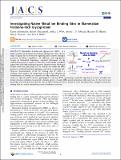Files in this item
Investigating native metal ion binding sites in mammalian histidine-rich glycoprotein
Item metadata
| dc.contributor.author | Ackermann, Katrin | |
| dc.contributor.author | Khazaipoul, Siavash | |
| dc.contributor.author | Wort, Joshua | |
| dc.contributor.author | Sobczak, Amelie Isabelle Sylvie | |
| dc.contributor.author | El Mkami, Hassane | |
| dc.contributor.author | Stewart, Alan J. | |
| dc.contributor.author | Bode, Bela Ernest | |
| dc.date.accessioned | 2023-04-03T09:30:14Z | |
| dc.date.available | 2023-04-03T09:30:14Z | |
| dc.date.issued | 2023-04-12 | |
| dc.identifier | 283777797 | |
| dc.identifier | ee21304c-9641-45d7-8d4d-79a878620347 | |
| dc.identifier | 37001144 | |
| dc.identifier | 85151865146 | |
| dc.identifier.citation | Ackermann , K , Khazaipoul , S , Wort , J , Sobczak , A I S , El Mkami , H , Stewart , A J & Bode , B E 2023 , ' Investigating native metal ion binding sites in mammalian histidine-rich glycoprotein ' , Journal of the American Chemical Society , vol. 145 , no. 14 , pp. 8064-8072 . https://doi.org/10.1021/jacs.3c00587 | en |
| dc.identifier.issn | 0002-7863 | |
| dc.identifier.other | ORCID: /0000-0002-0552-5784/work/132763907 | |
| dc.identifier.other | ORCID: /0000-0002-3384-271X/work/132764055 | |
| dc.identifier.other | ORCID: /0000-0003-4580-1840/work/132764482 | |
| dc.identifier.other | PubMedCentral: PMC10103162 | |
| dc.identifier.uri | https://hdl.handle.net/10023/27320 | |
| dc.description | Funding: For the purpose of open access, the authors have applied a Creative Commons Attribution (CC BY) license to any Accepted Author Manuscript version arising. They acknowledge support by the Wellcome Trust (204821/Z/16/Z), the British Heart Foundation (PG/15/9/31270 and FS/15/42/31556), and the Leverhulme Trust (RPG-2018–397). J.L.W. acknowledges support by the BBSRC DTP Eastbio. B.E.B. acknowledges equipment funding by BBSRC (BB/R013780/1 and BB/T017740/1). | en |
| dc.description.abstract | Mammalian histidine-rich glycoprotein (HRG) is a highly versatile and abundant blood plasma glycoprotein with a diverse range of ligands that is involved in regulating many essential biological processes, including coagulation, cell adhesion, and angiogenesis. Despite its biomedical importance, structural information on the multi-domain protein is sparse, not least due to intrinsically disordered regions that elude high-resolution structural characterization. Binding of divalent metal ions, particularly ZnII, to multiple sites within the HRG protein is of critical functional importance and exerts a regulatory role. However, characterization of the ZnII binding sites of HRG is a challenge; their number and composition as well as their affinities and stoichiometries of binding are currently not fully understood. In this study, we explored modern electron paramagnetic resonance (EPR) spectroscopy methods supported by protein secondary and tertiary structure prediction to assemble a holistic picture of native HRG and its interaction with metal ions. To the best of our knowledge, this is the first time that this suite of EPR techniques has been applied to count and characterize endogenous metal ion binding sites in a native mammalian protein of unknown structure. | |
| dc.format.extent | 9 | |
| dc.format.extent | 2656907 | |
| dc.language.iso | eng | |
| dc.relation.ispartof | Journal of the American Chemical Society | en |
| dc.subject | QD Chemistry | en |
| dc.subject | DAS | en |
| dc.subject | MCC | en |
| dc.subject.lcc | QD | en |
| dc.title | Investigating native metal ion binding sites in mammalian histidine-rich glycoprotein | en |
| dc.type | Journal article | en |
| dc.contributor.sponsor | The Leverhulme Trust | en |
| dc.contributor.sponsor | BBSRC | en |
| dc.contributor.sponsor | BBSRC | en |
| dc.contributor.sponsor | British Heart Foundation | en |
| dc.contributor.sponsor | British Heart Foundation | en |
| dc.contributor.sponsor | The Wellcome Trust | en |
| dc.contributor.institution | University of St Andrews. School of Chemistry | en |
| dc.contributor.institution | University of St Andrews. Institute of Behavioural and Neural Sciences | en |
| dc.contributor.institution | University of St Andrews. School of Physics and Astronomy | en |
| dc.contributor.institution | University of St Andrews. Sir James Mackenzie Institute for Early Diagnosis | en |
| dc.contributor.institution | University of St Andrews. Cellular Medicine Division | en |
| dc.contributor.institution | University of St Andrews. Biomedical Sciences Research Complex | en |
| dc.contributor.institution | University of St Andrews. School of Medicine | en |
| dc.contributor.institution | University of St Andrews. EaSTCHEM | en |
| dc.contributor.institution | University of St Andrews. Centre of Magnetic Resonance | en |
| dc.identifier.doi | 10.1021/jacs.3c00587 | |
| dc.description.status | Peer reviewed | en |
| dc.identifier.url | https://pubmed.ncbi.nlm.nih.gov/37001144/ | en |
| dc.identifier.grantnumber | RPG-2018-397 | en |
| dc.identifier.grantnumber | BB/T017740/1 | en |
| dc.identifier.grantnumber | BB/R013780/1 | en |
| dc.identifier.grantnumber | PG/15/9/31270 | en |
| dc.identifier.grantnumber | FS/15/42/31556 | en |
| dc.identifier.grantnumber | 204821/Z/16/Z | en |
This item appears in the following Collection(s)
Items in the St Andrews Research Repository are protected by copyright, with all rights reserved, unless otherwise indicated.

